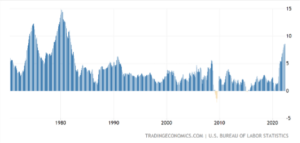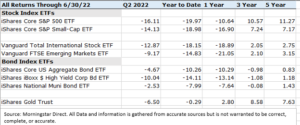Major stock and bond markets fell again in the second quarter of 2022. The news media has been very loud announcing that it was the worst first half of a year in half of a century. It is worth noting that there have been multiple six-month periods where returns were worse, they just did not fall on the dates Jan 1- June 30. While technically true, it is certainly sensationalized.
News media outlets sell ads. Dramatic headlines get attention. Cooler heads do prevail!
Inflation is also at levels not seen in decades. This is commonly held as the primary reason for the bear market that we are experiencing. In simple terms, Inflation means that your money buys less than before. There are two primary forms of inflation, Demand-Pull and Cost-Push.
Demand Pull is the result of more buyers than seller. The buyers bid up the prices of goods and services, competing against each other. This can be part of a healthy growing economy. This can also be influenced by government stimulus, as we saw in 2020.
Cost Push is when it cost more to make goods. There are more “losers” than “winners” in this form of inflation and is generally regarded as negative for an economy.
As illustrated above there are several factors that can cause both types of inflation (and is not an exhaustive list). The governments’ ability to ease cost-push inflation is limited. Reducing production costs (far right of the image) will involve forging new supply chains. Computer chips are in everything from refrigerators to cars to cell phones. Building a computer chip plant takes years and billions of dollars. It is worth noting that congress can’t get out of their own way to help get two major chip
factories started as this is being typed. Due to the challenges of fixing this type of inflation, our investment committee is anticipating elevated inflation to be sticky.
Does that mean we should change investment strategies? Probably not. Stock and bond markets anticipate all known factors, reflecting them in the current price. This is why we tend to see stock markets fall before a recession is official, and start to rebound while the recession is still happening. Our investment committee has taken measure over the previous years to include inflation hedges in our managed strategies.
While seeing a negative statement is certainly stressful, we need to remember that we are long-term investors that invest for a lifetime, not just our next statement. As stated above, we have seen half-year periods with more dramatic declines. We have also seen stock values rebound back, sometimes starting that rally in the middle of a recession.
This material represents an assessment of the market and economic environment at a specific point in time and is not intended to be a forecast of future events, or a guarantee of future results. Forward-looking statements are subject to certain risks and uncertainties. Actual results, performance, or achievements may differ materially from those expressed or implied. Information is based on data gathered from what we believe are reliable sources. It is not guaranteed as to accuracy, does not purport to be complete and is not intended to be used as a primary basis for investment decisions. It should also not be construed as advice meeting the particular investment needs of any investor.
‘Past performance does not guarantee future results. Investing involves risk, including the loss of principal.
‘The Standard & Poor’s 500 (S&P 500) is an unmanaged group of securities considered to be representative of the stock market in general. It is a market value weighted index with each stock’s weight in the index proportionate to its market value.
‘Neither Asset Allocation nor Diversification guarantee a profit or protect against a loss in a declining market. They are methods used to help manage investment risk.
Please consider the investment objectives, risks, charges, and expenses carefully before investing. The prospectus, which contains this and other information about the investment company, can be obtained directly from the Fund Company or your financial professional. Be sure to read the prospectus carefully before deciding whether to invest




